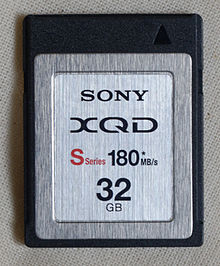
Back XQD German Tarjeta XQD Spanish XQD Finnish Carte XQD French XQDメモリーカード Japanese XQD 카드 Korean XQD NB XQD Romanian XQD Russian XQD Ukrainian
 | |
| Media type | Memory card |
|---|---|
| Capacity | Over 2 TiB |
| Developed by | CompactFlash Association |
| Dimensions | 38.5 mm × 29.8 mm × 3.8 mm |
| Usage | Digital cameras |

The XQD card is a memory card format primarily developed for flash memory cards. It uses PCI Express as a data transfer interface.
The format is targeted at high-definition camcorders and high-resolution digital cameras. It offers target read and write speeds from 1 Gbit/s to about 5 Gbit/s[1] and storage capabilities beyond 2 TiB.[2][3][failed verification]
The cards are not backward compatible with CompactFlash or CFast cards, and despite the name similarity, has no connection with the xD-Picture Card. XQD and CFast were both designed as a replacement of the 1994 CompactFlash standard.
The format was first announced in November 2010 by SanDisk, Sony and Nikon, and was immediately picked up by the CompactFlash Association for development.[4] The final specification was announced in December 2011.[1][5]
XQD version 2.0 was announced in June 2012, featuring support for PCI Express 3.0 with transfer rates up to 8 Gbit/s (1 GB/s).[6]
On 7 September 2016 the CFA announced the successor of XQD, CFexpress.[7] This new standard uses the same form-factor and interface but uses the NVMe protocol for higher speeds, lower latencies and lower power consumption.
- ^ a b "CompactFlash Association readies next-gen XQD format, promises write speeds of 125 MB/s and up". Engadget. December 8, 2011. Retrieved September 19, 2012.
- ^ "CompactFlash Association Announces the Recently Adopted XQD(TM) Specification as a New Memory Card Format". CompactFlash Association. December 7, 2011. Archived from the original on January 25, 2012. Retrieved January 17, 2012.
Actual Write Speeds Target 125 MB/sec and Higher
- ^ "What is XQD and Why Should I use it | Nikon". www.nikonusa.com. Retrieved April 29, 2023.
- ^ "Sandisk, Sony, and Nikon propose 500 Mbps memory card with more than 2 TB capacity". Engadget. November 30, 2010. Retrieved September 19, 2012.
- ^ "CompactFlash Association Announces XQD Card Format". Compactflash.org. December 7, 2011. Archived from the original on September 29, 2012. Retrieved September 19, 2012.
- ^ "The CompactFlash Association Invites Participation on XQDTM 2.0 — The CompactFlash Association". Compactflash.org. September 15, 2012. Archived from the original on September 19, 2012. Retrieved September 19, 2012.
- ^ Cite error: The named reference
cforg_2016_09_07was invoked but never defined (see the help page).